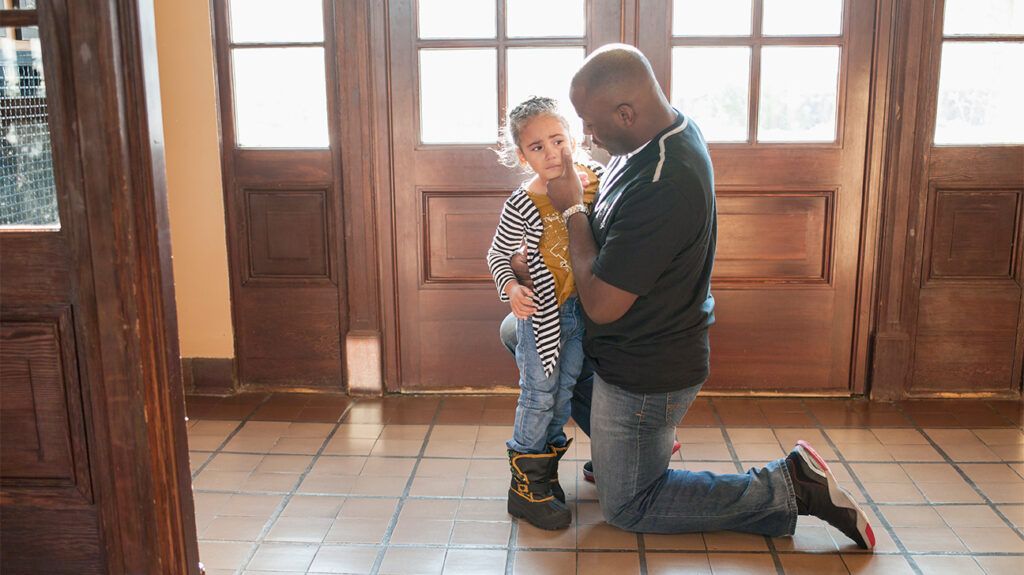It can be tough to hear your child speak negatively about themselves. But modeling a progress-not-perfection ethic can help decrease their negativity.

It’s natural to feel concerned when “can’t do” thinking stands in the way of your child reaching for success.
Unhelpful statements, such as “I’m bad at math” or “Nobody likes me. I can’t make friends,” can impact their mental and emotional health. But it’s possible to encourage more positivity.
Identifying negative thinking patterns in your child may be a key step in fostering their realism and resilience. Reassuring and guiding them through helpful techniques may help your child develop positive thought patterns.
Jean Muhammad, a student service specialist at Ames Community School District in Ames, Iowa, and Laura Tracey, a reading interventionist at Winthrop Elementary School in Massachusetts, identify negative thinking types they see all the time.
For example, a child may disproportionately blame themselves for a mistake. Consider the educators’ observations to help you know other signs that can help you identify negative thought patterns:
- A fixed mindset: Muhammad explains, “This shows up in the classroom as the student who has their head down on the desk and says, ‘I can’t do this,’ while the worksheets are still being handed out. Or the one who says, ‘I’m not even going to try out for basketball. I’m probably not going to make it anyway.’”
- Negative mind reading: Maybe one bully told your kid they were dumb, but now they “just know” everyone shares this opinion.
- Negative comparisons: Muhammad sees this frequently in teens. Kids believe the filtered images they see on Instagram or TikTok and judge themselves as unworthy by comparison.
- Shutting down: Obstacles can be real, but kids need problem-solving to cope.
- Holding onto problems: Tracey says she sees this, particularly during transitions.
Negative thought patterns common in children with mental health disorders
A large 2022 study suggests that repetitive negative thinking is linked to depression and anxiety in adolescents.
According to Juliann Garey, writing for the Child Mind Institute, negative thinking can increase depression and anxiety in kids with mental health disorders. These include:
- negative self-labeling
- belief in negative thoughts as facts
- filtering out positive feedback
Some mental health disorders and neurological disorders may have negative thinking as a symptom:
- Attention deficit hyperactivity disorder (ADHD) can be associated with black-and-white thinking or anger at self.
- Social anxiety can lead to withdrawal from social situations due to negative thinking.
Depression is associated with negative thoughts of self and decreased emotional suppression.
Collaborating with your kid by taking a mindful approach.to separate them from their unhelpful thoughts is key. Consider the following tips to help your child cultivate a healthy and positive mindset.
1. Encouraging positive thinking
Muhammad suggests parents encourage positivity by:
- celebrating their children’s efforts as much or more than their accomplishments
- reminding children of a time they felt they wouldn’t be successful but then worked hard to achieve a goal
- helping to shift their thoughts from “I can’t” to “Oh yeah, maybe I can.’
A
According to the study, students thinking about their efforts sustained test-taking concentration better than those thinking about their ability, regardless of how competent they felt.
Louisa Brandeis Popkin, a Massachusetts-based special education administrator, recommends growth mindset strategies to increase optimism in children and teens:
- adding “as of yet” to the phrase “I cannot do it.”
- reminding “everybody makes mistakes”
- reflecting, “would you say that to a friend?”
- creating a “can do” list and adding to it regularly
- responding to challenges with “mistakes mean I am learning”
2. Encourage realistic expectations
Muhammad says parents can support their children’s resilience by teaching realistic expectations. Her suggestions include the following:
- Resist the temptation to remove obstacles for them.
- Support them in overcoming obstacles.
- Teach failure is a part of growth
- Delay social media use and educate them about misrepresentation.
Consider checking that your expectations are realistic, based on your child’s needs and abilities, rather than pressuring, based on your own needs and abilities.
3. Help your child separate from their negative thoughts
“Distraction can be everything,” says Tracey. “Students will come to school complaining about a problem and refusing to work.”
“I’ll say something like, ‘that sounds uncomfortable’; I was just rushing to buy cat food. Do you have a cat?”
- Tracey gives the child, not the problem, her attention, something parents can try.
- She listens to their feelings and offers an experience of her own to engage them.
- Then she redirects them to a new thought before drawing them back to work.
If your child experiences unhelpful thoughts about themselves, it may take time before you notice a change in their mindset.
Try to offer a safe and non-judgmental space for them to feel supported as they learn to adopt more balanced views of themselves and their abilities.
You may also consider practicing some of the strategies above for yourself, this can help you model positivity as you encourage your child to do the same.
If you would like support during this time, consider cognitive behavioral therapy (CBT) with a therapist who can help guide your child to become aware of how their unhelpful thoughts affect them.
